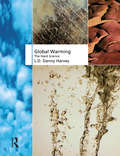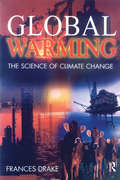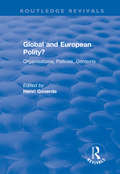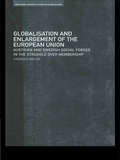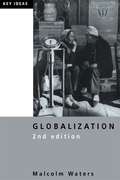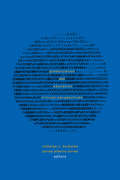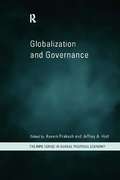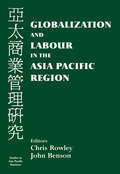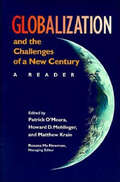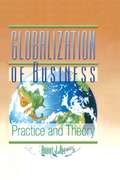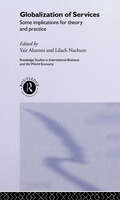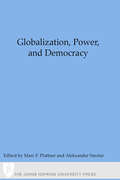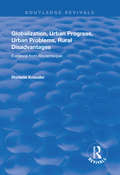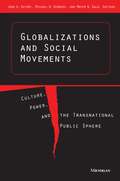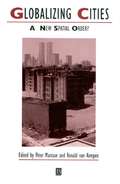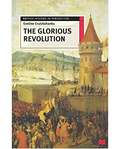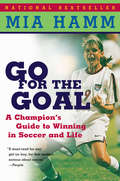- Table View
- List View
Global Warming
by L. D. HarveyGlobal Warming: The Hard Science presents a comprehensive, qualitatively rigorous, and critical discussion of the science underlying the global warming issue. The major processes in the climate system needed to understand projected human-induced climatic change are presented in detail. Observational systems used to monitor changes in the climate system and the ways in which the raw data are analyzed in order to produce estimates of current trends are also critically reviewed. The author discusses the hierarchy of computer models used to project changes in the carbon cycle, in climate, and in sea level and examines the physical principles underlying the greenhouse effect and projected warming. The text also presents a detailed discussion of the carbon cycle, of climate sensitivity, and of projected patterns of climatic change through time. Sea level rise and issues of risk and potential surprises are also critically assessed. Emphasis is placed throughout on developing an intuitive understanding of those results that do not depend on the details of any one computer simulation model. A series of boxes illustrate the key points through step-by-step calculations.
Global Warming: The Science Of Climate Change (A\hodder Arnold Publication)
by Frances DrakeFirst published in 2000. Routledge is an imprint of Taylor & Francis, an informa company.
Global and European Polity?: Organisations, Policies, Contexts
by Henri GoverdeThis title was first published in 2000: The contents of this text are structured by three sub-themes. Firstly, the internationalization of Europe. This field studies threats and chances of re-institutionalization of nation-state societies and the role of the public sector therein, acknowledging the dynamics of the ever-changing international political and economic relations. The second sub-theme is the creative firm in a European context. The object of this field is the conditions for innovative organization and management of firms in Europe, taking into account the necessary adjustments to emerging European political and economic transformations. The final sub-theme is innovative environmental and spacial policy in a European context. This section has its object in the far-reaching transformations that European societies and particularly the Dutch societies are witnessing. These transformations concern the functional relations and spatial and environmental conditions as well as the emerging changes in the way planning and policy institutions deal with their new targets.
Globalisation and Enlargement of the European Union: Austrian and Swedish Social Forces in the Struggle over Membership (Routledge Studies in Globalisation)
by Andreas BielerOn January 1 1995, Austria and Sweden joined the European Union (EU). This book examines why these two countries joined at such a moment and studies their accession against the structural background of globalization. In this cutting-edge analysis, Andreas Bieler argues that conventional neo-functionalist and intergovernmentalist theories fail to explain such structural change as they take existing power structures as given. Therefore, he develops a neo-Gramscian perspective as an alternative approach to European integration.
Globalization (Key Ideas)
by Malcolm WatersThe constraints of geography are shrinking and the world is becoming a single place. Globalization and the global society are increasingly occupying the centre of sociological debates. Widely discussed by journalists and a key goal for many businesses, globalization has become a buzz-word in recent years. In this extensively revised and restructured new edition of Globalization , Malcolm Waters provides a user-friendly introduction to the main arguments about the process, including a chapter on the critiques of the globalization thesis that have emerged since the first edition was published.
Globalization and Catching-Up: From Recession to Growth in Transition Economies
by Grzegorz W. KolodkoA report from the International Monetary Fund.
Globalization and Education: Critical Perspectives (Social Theory, Education And Cultural Change Ser.)
by Carlos Alberto Torres Nicholas C. BurbulesFirst Published in 2000. Routledge is an imprint of Taylor & Francis, an informa company.
Globalization and Governance (RIPE Series in Global Political Economy #Vol. 1)
by Aseem Prakash Jeffrey A. HartGlobalization and Governance is a completely up-to-date, impartial survey of a variety of perspectives on what constitutes governance and how globalization may impact governance and the state. Eleven essays and a thorough introduction provide a theoretical framework and a literature overview. Unlike most books on the subject, this does not espouse any ideological agenda and examines the topical subject of globalization in a conceptually rigorous way.
Globalization and Growth in The Twentieth Century
by Nicholas CraftsA report from the International Monetary Fund.
Globalization and Labour in the Asia Pacific
by John Benson Chris RowleyGlobalization and labour market deregulation have had an impact on employment and workers, and brought pressure to bear on trade unions. This study looks at the challenges of globalization and deregulation in the Asia Pacific, and possible responses to them in a variety of ways.
Globalization and Networked Societies: Urban Regional Change in Pacific Asia
by Yue-Man YeungGlobalization, along with globalism, continues its unrelenting and accelerating march as it draws more countries, cities, and people closer into interdependent relationships. Globalization and Networked Societies attempts to tease out some of the salient elements of this process, especially as it has affected urban centers in Pacific Asia over the past twenty years.
Globalization and the Challenge of a New Century
by Patrick O'Meara Howard Mehlinger Matthew KrainThis book focuses on globalization while at the same time reaffirming the importance of the area concept
Globalization and the Challenges of a New Century: A Reader
by Patrick O’Meara, Howard D. Mehlinger and Matthew Krain"If you want to catch up on some of the best articles written about globalisation since the topic became fashionable several years ago, this reader is the place to start." —The Economist A blue ribbon collection of major articles and position papers on the concept of globalization. By bringing together a number of major thinkers and different perspectives, this book provides a broad introduction to the topic and lays the groundwork for an interdisciplinary collaborative dialogue. Contributors include Kofi Annan, Benjamin Barber, Francis Fukuyama, Samuel Huntington, Robert Kaplan, Paul Kennedy, Walter Lacqueur, Bill McKibben, Lester Thurow, and Jeffrey Sachs.
Globalization and the Future of Social Protection
by Vito TanziA report from the International Monetary Fund.
Globalization of Business: Practice and Theory
by Erdener Kaynak Abbas J AliCreate a successful strategy for competition in the global marketplace!Globalization of Business: Practice and Theory will give executives and business students a current, in-depth look at ways to become globally competitive in today's complex market. This essential guide offers you insight into issues every global businessperson needs to
Globalization of CEMEX
by Pankaj Ghemawat Jamie L. MatthewsCEMEX is a Mexican company that has become a major international competitor in cement while maintaining a higher level of profitability than other, longer-established majors. CEMEX's superior profitability supplies a basis for discussing the sources of superior performance in a global context. In addition, the wide array of benefits that CEMEX derives from its operations in different countries broadens conventional notions of why firms globalize.
Globalization of Services: Some Implications for Theory and Practice (Routledge Studies In International Business And The World Economy Ser. #Vol. 19)
by Yair Aharoni Lilach NachumIn an era of accelerating change in the world economy, services are assuming greater importance for the economies of both developed and developing countries. As technological developments allow increasing tradeability of services, huge global firms are offering services across national boundaries. This important book explores the global impact of t
Globalization, Power, and Democracy (A Journal of Democracy)
by Marc F. Plattner and Aleksander SmolarEssays exploring a world dramatically transformed by the collapse of communism—and the prospects for democracy in that realigned reality.The breakup of the Soviet Union’s external empire in Eastern Europe, soon followed by the demise of the USSR itself, destroyed the bipolar structure that had characterized world politics for almost half a century. But while the dramatic collapse of communism left no room for doubt that the era of the Cold War had come to an end, there was very little agreement about the nature of the new international order being born.This book explores the emerging post-Cold War international system and its implications for the future expansion and consolidation of democracy. Bringing together both experts on international relations and scholars of democracy from Europe, North America, and Asia, it examines the link between these two subjects in a way that is rarely done. While a large literature has emerged in recent years on the effects of democracy on international relations (the debate over what is often called the theory of “democratic peace”), the authors of this volume instead examine the other side of this relationship—the impact of the international system on the prospects for democracy.Contributors: Zbigniew Brzezinski, Center for Strategic and International Studies • Robert Cooper, Defence and Overseas Secretariat in the Cabinet Office, London • Jean-Marie Guéhenno, Institut des Hautes Etudes de Défense Nationale, Paris • Samuel P. Huntington, Harvard University • Robert Kagan, Carnegie Endowment for International Peace • Ethan B. Kapstein, University of Minnesota • Kyung Won Kim, Institute of Social Sciences • Jacques Rupnik, Fondation Nationale des Sciences Politiques, Paris • Dimitri Landa, University of Minnesota • Adam Daniel Rotfeld, Stockholm International Peace Research Institute, Stockholm • Philippe C. Schmitter, European University Institute, Florence
Globalization, Technological Developments, and the Work of Fiscal Termites 1
by Vito TanziA report from the International Monetary Fund.
Globalization, Urban Progress, Urban Problems, Rural Disadvantages: Evidence from Mozambique (Routledge Revivals)
by Stefanie KnauderThis title was first published in 2000: This text demonstrates the mutual effects of, and interconnections between, globalization, urbanization and rural stagnation, both theoretically and empirically. It places its comprehensive empirical investigation on two levels of urbanization - the peri-urban and the fully urbanized areas - and includes the analysis of the rural conditions into the context of the Southern African region, and also into the context of global processes in an historical and interdisciplinary perspective. The text analyzes the magnitude of the two gaps and the process of social change between the three areas objectively, by showing the changing social interaction patterns, the differences in housing and other socio-economic variables, and subjectively, through showing the judgement of the people of these variables the degree of satisfaction and depression. As the majority of variables reveal poverty, the root causes for it in Mozambique, Africa and the Third World are analyzed and aspects of an alternative development and an alternative globalization are presented.
Globalizations and Social Movements: Culture, Power and the Transnational Public Sphere
by John A. Guidry Michael D. Kennedy Mayer N. ZaldThis clear and concise book examines the crucial relationship between globalization and social movements. Deftly combining nuanced theory with rich empirical examples, leading scholar Valentine M. Moghadam focuses especially on three transnational social movements--Islamism, feminism, and global justice. Defining globalization as a complex process in which the mobility of capital, peoples, organizations, movements, and ideas takes on an increasingly transnational form, the author shows how both physical and electronic mobility has helped to create dynamic global social movements. Globalization has engendered the spread of neoliberal capitalism across the world, but it also has engendered opposition and collective action. Exploring the historical roots of Islamism, feminism, and global justice, the book also shows how these movements have been stimulated by relatively recent globalization processes, including neoliberalism, war, and hegemonic masculinities. Moghadam examines similarities and differences among the three movements, along with internal differentiation within each. Her argument is informed by feminism, world-systems, world polity, and social movement theories in a seamlessly integrated framework that will be essential reading for all students of globalization.
Globalizing Cities: A New Spatial Order? (IJURR Studies in Urban and Social Change Book Series)
by Ronald Van Kempen Peter MarcuseThis exciting collection of original essays provides students and professionals with an international and comparative examination of changes in global cities, revealing a growing pattern of social and spatial division or polarization.
Glorious Revolution (British History in Perspective)
by Eveline CruickshanksThe aim of this book is to set the Glorious Revolution in its religious, political and diplomatic background and examine its consequences for Britain and Europe. Cruickshanks discusses the problems of the reign of James II that led to the invasion of William of Orange in November 1688. The book summarises and interprets the best in the many collections of essays published for the Tercentenary of the Glorious Revolution, as well as works published since. The Whig interpretation of history, the impact of the Revolution on Scotland and Ireland, and conventional wisdom on the constitutional settlement and the Financial Revolution are all reviewed in a new light.
Glycoprotein Methods and Protocols
by Anthony P. CorfieldAnthony P. Corfield and a group of hands-on expermentalists bring together in Glycoprotein Methods and Protocols: The Mucins a state-of-the-art collection of reliable and tested methods for the study of all aspects of mucins. These powerful methods range from the preparation of mucins to their detection and quantitation with molecular biological and biochemical reagents. Also included are methods for the assessment of mucin peptide and carbohydrate, of mucin biosynthesis and degradation, and of mucin bacteriology and cell biology. Glycoprotein Methods and Protocols: The Mucins offers today's researchers a complete range of readily reproducible analytical techniques for the analysis of mucins.
Go For The Goal
by Mia Hamm"When I was playing, they said soccer was a mans world and that women should remain on the sidelines. All I can say is Im glad I never had to go up against Mia Hamm. "-- Pele <P><P>For the more than seven million girls--from knobby-kneed tykes to high school and college stars--who are tearing across the country chasing a soccer ball and dreams of glory, there is one name that eclipses all others, male or female: Mia Hamm. <P>With her cheetah-like acceleration and lightning bolt shot, Hamm has broken nearly every record in her sport, while galvanizing a whole new generation of fans and players. <P>Go for the Goal is not only the inspiring story of how a tiny suburban sprite became a global terror with a ball (and the world) at her feet--its also a step-by-step or dribble-by-dribble guide for any kid with the all-American dream of making the team and becoming a champion. <P>Filled with personal anecdotes and fully illustrated with both action and instructional photos, Go for the Goal shows readers exactly how to master the silky skills and techniques that have made Hamm and her teammates the finest women's soccer team in the world.
